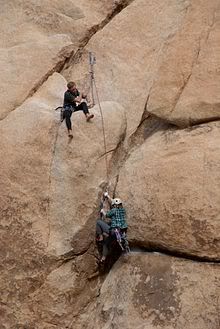by Viceroy63
The strategy proposed in this article is best applied to doubles game with 8 players and Trench Warfare settings. Although the principle can also be use in any type of double games. Realize also that all strategies are subject to actual game conditions and original drops.
There are basically three kinds of climbing; Slab, Vertical and Overhang climbing. Each one more difficult then the next because of the angle of inclination. Slab climbing is where the angle of inclination is less then 90 degrees allowing the climber to maintain his weight over his legs and basically using his arms for balance. In vertical climbing, the more popular form of climbing, the angle is more or less 90 degrees straight up and down. Indoor wall climbing is one of the most popular form of Vertical climbing. And the most difficult form of climbing is Overhang rock climbing. This type of climbing requires incredible upper body and arm strength.

Photo from the Sylvester Stallone Movie, "Cliff Hanger."
But of all the types of climbing there is, the prolonged vertical cliff climb over a great height is the most dangerous of all requiring a team mate in order to insure safety from fatigue and falling. And here is where we begin our lesson for team games. The following is an excerpt describing Lead Climbing. It is a technique or Tactic, for Team climbing over great heights.

Leader belays the second on Illusion Dweller in Joshua Tree National Park, USA
In lead climbing, one person, called the "leader," will climb from the ground up with a rope directly attached to his harness,and not through a top anchor. The second person, "belays" the leader by feeding out enough rope to allow upward progression without undue slack. As the leader progresses he clips the rope through intermediate points of protection such as active cams, or passive protection such as nuts; this limits the length of a potential fall. The leader also may clip into pre-drilled bolts.
Because the climbing rope is of a fixed length, the leader can only climb a certain distance. Thus longer routes are broken up into several "pitches"; this is called "multi-pitching". At the top of a pitch, the "leader" sets up an anchor and then belays the "second" up to the anchor; as the "second" follows the route taken by the "leader," the second removes the equipment placed along the way in order to use it again on the next "pitch." Once both are at the anchor, the "leader" begins climbing the next pitch and so on until the top is reached.
-http://en.wikipedia.org/wiki/Rock_climbing#Rock_climbing_basics
In other words, one of the team climbers is actually climbing while the other is at rest or anchored. The one that is climbing is also securing hooks in the face of the cliff as he climbs to insure that should any of the team climbers lose their footing and falls, that they wont fall very far. One is the climber while the other is the anchor. Both can not be climbing and anchoring at the same time for then they both take the risk that neither of them would be a very secure anchor. In an unforeseen moment, both could fall down together, as a team, toward the cold hard earth below ending their climb if one of the two climbers is not a secured anchor. But both climb and reach the top together in a safe and secure manner, resting and climbing as they go taking turns doing each.
In team games, especially when there are four teams involved, this tactic can be utilized to insure the most optimum amount of success possible. This tactic is especially useful in Trench Warfare settings where the climbing and fighting is slow and difficult. The first member of the team helps the second member of the team to establish a position or foot hold or even a bonus zone by providing his extra troops to that member of the team and once that goal is achieved, the second player then becomes the anchor and simply holds position while the first player now climbs and expands in the number of regions that he possesses until he reaches a position where he can become the anchor once more holding position so that the second player can commence climbing and growing in regions again. And so it goes one player holding position and helping the team mate, while the other climbs and grows in regions and position. Then they exchange roles again back and fourth as necessary or until the game is won.
The actual game conditions may require that one player be the climber or fighter as the other props the fighter throughout the entire game. I like to refer to this as the Sword and the Shield. In these types of doubles games, the first player will prop the second player by providing his troops to the second player in order to maximize his attacks. This particular strategy is best played in no spoils game. But even in Spoils game there may arrive a point where one of the two may have to settle for holding position while Propping the second player for a prolonged period of time. It all depends on the actual game conditions. Just as the time may come when it is every player for himself when all the other teams are attacking from every angle. The game situation is what really determines the best course of actions.
But all things being equal, when you compare any kind of climbing and consider that you only use one arm and leg at a time in the process and apply that logic to double team games (Where the team is the body and the two players form the two sides of the body) then it only seems best that one of the team members hold on to the ladder (position) while the other team member reaches for the higher run of the ladder. For both arms or both partners in the team to be used at the same time to expand and gain regions simultaneously will incur certain risk and loss in efficiency and strength. This does not mean that both team members can not card on their turns, only that the fight for position and bonus zones should be done as a team coordinated effort and not as individual attempts. One of the team members need to be strong and getting stronger in order to help out the other team member to climb/fight as well. As both team members become stronger using this strategy, the team eventually gains the better position and the eventual win.
The dice gods providing.
-End.
783










































